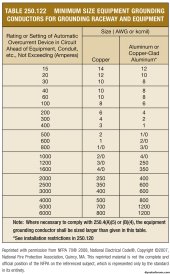In getting ready to wire up my ground mount (finally), I know NEC says that ground wire subject to damage needs to be AWG 6. Ok. So I wire up the exposed panel/array grounding wire as AWG 6.
So say I connect said ground wire to a busbar in my combiner box and want to run said ground wire along with my + and - PV wires underground in RMC back to the side of the barn where my required disconnect is, so as to connect this ground wire to the ground rod beneath the disconnect where the rest of the system will also be grounded. Does said underground wire also need to be AWG 6?
My thought is that it does not. Only the exposed ground wires, such as on the array itself, and from the disconnect box down to the ground rod need to be AWG 6. I can probably do AWG 10 for the underground portion of the ground wire. (I will do AWG 8 for the PV +/- as I am concerned about voltage drop based on various calculators online).
For reference I am doing an off-grid solution to provide power for my barn. And yes I am subject to inspection.
Am I correct in my thoughts as to underground ground wire size? Thanks
So say I connect said ground wire to a busbar in my combiner box and want to run said ground wire along with my + and - PV wires underground in RMC back to the side of the barn where my required disconnect is, so as to connect this ground wire to the ground rod beneath the disconnect where the rest of the system will also be grounded. Does said underground wire also need to be AWG 6?
My thought is that it does not. Only the exposed ground wires, such as on the array itself, and from the disconnect box down to the ground rod need to be AWG 6. I can probably do AWG 10 for the underground portion of the ground wire. (I will do AWG 8 for the PV +/- as I am concerned about voltage drop based on various calculators online).
For reference I am doing an off-grid solution to provide power for my barn. And yes I am subject to inspection.
Am I correct in my thoughts as to underground ground wire size? Thanks



